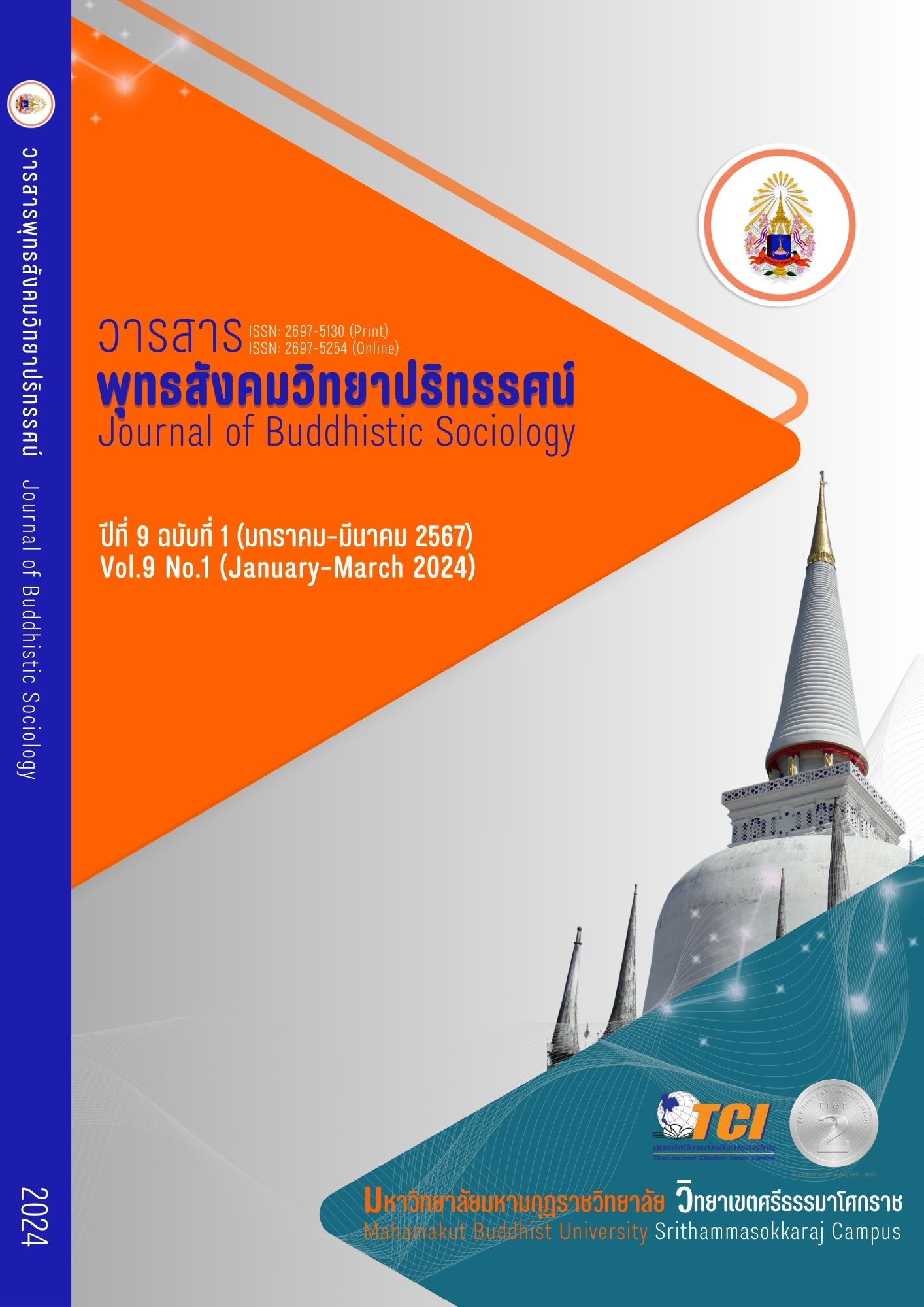AN APPLICATION OF TECHNOLOGY TO DISSEMINATE BUDDHIST ART IN THE PRESENT ERA
Main Article Content
Abstract
The article on the topic of applying technology to disseminate Buddhist art in the modern era aimed to 1) study the application of technology to propagate Buddhist art in the modern era, 2) study and compare the propagation of Buddhist art in the present that is different from the past, and 3) present guidelines for using technology to access Buddhist art in Buddhism. This study employed various methods to allow Buddhists to access information sources conveniently and quickly. The study found that 1) The use of technology by Buddhists to study and research Buddhist artworks still needed to be evident and accepted. 2) Methods and ideas for propagating Buddhist art using technology different from before have been initiated. 3) There were guidelines for using technology that is a leap forward from the past because nowadays, there is a technology that allows Buddhists to access information sources conveniently and quickly. It allows Buddhists interested in Buddhist arts to search for information through various channels such as television, movies, magazines, books, or social media technology. Applying technology to modern Buddhist art will allow Buddhists to access Buddhist art conveniently and quickly. Therefore, various media systems are essential in conveying the principles and teachings of Buddhism through interesting Buddhist artworks, making it easier to influence people's minds even more. Therefore, it is important to create educational opportunities to learn Buddhist art by being able to search for information and sources of knowledge without borders.
Article Details

This work is licensed under a Creative Commons Attribution-NonCommercial-NoDerivatives 4.0 International License.
References
กรมการศาสนากระทรวงวัฒนธรรม. (2562). แผนยุทศาสตร์ระยะ 5 ปี (พ.ศ. 2560-2565). เรียกใช้เมื่อ 25 กันยายน 2566 จาก https://www.dra.go.th/files/download/download_document_02e88effbc22e3dff028d0854396e2d2.pdf
โกสุม สายใจ. (2560). พุทธศิลป์กับการจัดการความรู้. วารสารมนุษยศาสตร์และสังคมศาสตร์ มหาวิทยาลัยราชพฤกษ์, 3(1), 1-10.
จุรี วิจิตรวาทการ. (2558). ดัชนีชี้วัดภาพลักษณคอรรัปชันโลก. เรียกใช้เมื่อ 27 กันยายน 2566 จาก http://thaipublica.org/2016/01/corruption-percep tions-index-2015-thailand/
ชยาภรณ์ สุขประเสริฐ. (2559). พุทธศิลป์: ถิ่นไทย ศิลปกรรมเพื่อพระพุทธศาสนา. วารสารพุทธอาเซียนศึกษา, 1(2), 59-74.
ดารา ทีปะปาล และคณะ. (2533). การสื่อสารการตลาด= Marketing communications (ปรับปรุงใหม่) (พิมพ์ครั้งที่ 1). กรุงเทพมหานคร: อมรการพิมพ์.
พจน์ศิรินทร์ ลิมปินันทน์. (2560). เทคโนโลยีความเป็นจริงเสริมส่งเสริมความคงทนในการจำคำศัพท์ภาษาอังกฤษ. วารสารการจัดการเทคโนโลยีสารสนเทศและนวัตกรรม, 4(6), 7-16.
พระครูภัทรจิตตาภรณ์ และคณะ. (2563). ศึกกษาประเพณี พิธีกรรมกับคติความเชื่องานฌาปนกิจศพในกระแสบริโภคนิยม. รายงานสืบเนื่องจากการประชุมวิชาการระดับชาติครั้งที่ 7 “วิถีพุทธ วิถีชุมชน รากฐานชีวทัศน์เชิงสังคมล้านนาในสังคมวิถีใหม่”. นครราชสีมา.
พระครูวิสุทธานันทคุณ (สุรศักดิ์ วิสุทฺธาจาโร). (2557). การบริหารจัดการวัดเพื่อความมั่นคงแห่งพระพุทธศาสนา. ใน ปริญญาพุทธศาสตรดุษฎีบัณฑิต สาขาวิชาการจัดการเชิงพุทธ. มหาวิทยาลัยมหาจุฬาลงกรณราชวิทยาลัย.
พระฏุลากาญ กิตฺติคุตฺโต. (2561). สื่อใหม่กับการเผยแผ่พระพุทธศาสนาในยุคปัจจุบัน. วารสารวิชาการ สถาบันพัฒนาพระวิทยากร, 1(2), 106-118.
พระเทพปริยัติสุธี. (2545). การคณะสงฆ์และการพระศาสนา. กรุงเทพมหานคร: โรงพิมพ์มหาจุฬาลงกรณราชวิทยาลัย.
พิชญ์สินี พุทธิทวีศรี และคณะ. (2560). นวัตกรรมสร้างสรรค์ด้วยเทคโนโลยีเสมือนจริง 3 มิติ เพื่อส่งเสริมการท่องเที่ยวเกาะรัตนโกสินทร์อย่างยั่งยืน. ใน รายงานการวิจัย. มหาวิทยาลัยสวนดุสิต.
เมธี เชษฐ์วิสุต. (2562). สื่อสังคมออนไลน์กับการเผยแผ่พระพุทธศาสนา. วารสารพุทธศาสตร์ศึกษา, 10(2), 521-531.
สงวน รอดบุญ. (2545). พุทธศิลปลาว. กรุงเทพมหานคร: สายธาร.
McLuhan, M. (1964). Understanding media: The extensions of man. New York: McGraw-Hill book.


